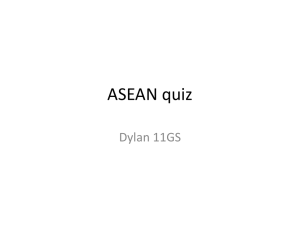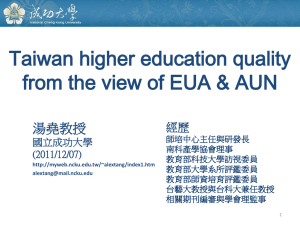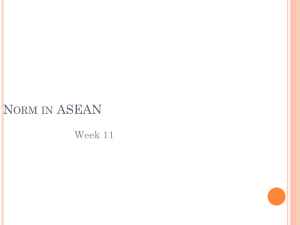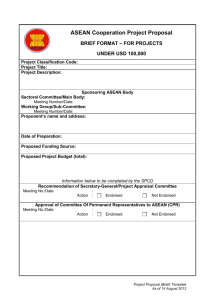REVISITING ASEAN` PRINCIPLE OF NON
advertisement
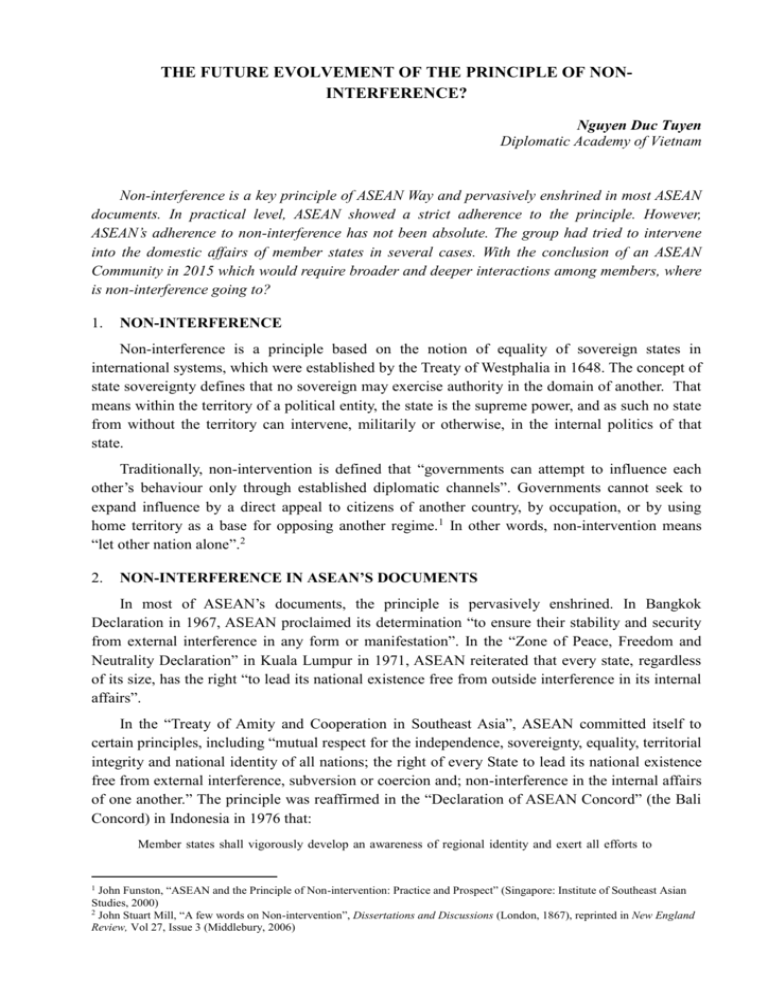
THE FUTURE EVOLVEMENT OF THE PRINCIPLE OF NONINTERFERENCE? Nguyen Duc Tuyen Diplomatic Academy of Vietnam Non-interference is a key principle of ASEAN Way and pervasively enshrined in most ASEAN documents. In practical level, ASEAN showed a strict adherence to the principle. However, ASEAN’s adherence to non-interference has not been absolute. The group had tried to intervene into the domestic affairs of member states in several cases. With the conclusion of an ASEAN Community in 2015 which would require broader and deeper interactions among members, where is non-interference going to? 1. NON-INTERFERENCE Non-interference is a principle based on the notion of equality of sovereign states in international systems, which were established by the Treaty of Westphalia in 1648. The concept of state sovereignty defines that no sovereign may exercise authority in the domain of another. That means within the territory of a political entity, the state is the supreme power, and as such no state from without the territory can intervene, militarily or otherwise, in the internal politics of that state. Traditionally, non-intervention is defined that “governments can attempt to influence each other’s behaviour only through established diplomatic channels”. Governments cannot seek to expand influence by a direct appeal to citizens of another country, by occupation, or by using home territory as a base for opposing another regime.1 In other words, non-intervention means “let other nation alone”.2 2. NON-INTERFERENCE IN ASEAN’S DOCUMENTS In most of ASEAN’s documents, the principle is pervasively enshrined. In Bangkok Declaration in 1967, ASEAN proclaimed its determination “to ensure their stability and security from external interference in any form or manifestation”. In the “Zone of Peace, Freedom and Neutrality Declaration” in Kuala Lumpur in 1971, ASEAN reiterated that every state, regardless of its size, has the right “to lead its national existence free from outside interference in its internal affairs”. In the “Treaty of Amity and Cooperation in Southeast Asia”, ASEAN committed itself to certain principles, including “mutual respect for the independence, sovereignty, equality, territorial integrity and national identity of all nations; the right of every State to lead its national existence free from external interference, subversion or coercion and; non-interference in the internal affairs of one another.” The principle was reaffirmed in the “Declaration of ASEAN Concord” (the Bali Concord) in Indonesia in 1976 that: Member states shall vigorously develop an awareness of regional identity and exert all efforts to John Funston, “ASEAN and the Principle of Non-intervention: Practice and Prospect” (Singapore: Institute of Southeast Asian Studies, 2000) 2 John Stuart Mill, “A few words on Non-intervention”, Dissertations and Discussions (London, 1867), reprinted in New England Review, Vol 27, Issue 3 (Middlebury, 2006) 1 create a strong ASEAN community, respected by all and respecting all nations on the basis of mutually advantageous relationships, and in accordance with the principles of self-determination, sovereign equality and non-interference in the internal affairs of nations. In ASEAN Charter announced in 2007, ASEAN reaffirmed its intention to “respecting the fundamental importance of amity and cooperation, and the principles of sovereignty, equality, territorial integrity, non-interference, consensus and unity in diversity;” at the Preamble. At Article 2, ASEAN reaffirms to adhering to fundamental principles, including: 3. respect for the independence, sovereignty, equality, territorial integrity and national identity of all ASEAN Member States; renunciation of aggression and of the threat or use of force or other actions in any manner inconsistent with international law; non-interference in the internal affairs of ASEAN Member States; respect for the right of every Member State to lead its national existence free from external interference, subversion and coercion; THE PRACTICE OF NON-INTERFERENCE In practice, ASEAN members pursue a strict adherence to non-interference. The principle has been adopted by ASEAN members at four main aspects: First, ASEAN members refrain from criticising the actions of other member governments towards their own people, including human rights violation and from making the domestic political system of states and the political styles of governments a basis for deciding their membership in ASEAN; Second, member countries will criticise the actions of the states which were deemed to have breached the principle of noninterference; Third, member countries will deny to recognise or to supply sanctuary or any other forms of support to any rebel group seeking to destabilise or overthrow the government of a neighbouring state and; Fourth, ASEAN will provide political support and material assistance to member states in their campaign against subversion and destabilising activities.3 There were several examples of the first aspect of ASEAN’s adherence to non-interference can be found. During the “People’s Power Revolution” against Marcos regime in the Philippines in 1986, ASEAN made no criticisms even when a martial law was announced by Marcos regime. ASEAN also did not response to the Thai’s military crackdown on pro-democracy demonstrators in May 1992 and most recently, in May 2010. No criticisms from ASEAN were made as well in the after math of the Dili massacre conducted by Indonesian troops in November 1991. Even when a Malaysian TV screened a CNN report showing graphic scenes of the massacre, Malaysian Prime Minister Mahathir Mohammad had to send his Information Minister to Jakarta as personal envoy to extend apologies,4 just because of non-interference. The second aspect could be explained by ASEAN’s response to Vietnam’s intervention in Cambodia in 1978. In the statement issued on 9th January 1979, ASEAN foreign ministers collectively urged all countries in the region “to respect each other’s independence, sovereignty, territorial integrity and political system” and “refrain from interfering in each other’s internal affairs, and from carrying out subversive activities, directly or indirectly against each other.”5 3 Amitav Acharya, Constructing a Security Community in Southeast Asia: ASEAN and the Problem of Regional order (second edition) (Routledge, 2009), pp 72 4 John Funston, Ibid 5 Amitav Acharya, Ibid, pp 73 The third aspect, the policy of not supporting rebellions fighting against central government in an ASEAN member originated from ASEAN’s concern that trans-boundary insurgent movements could be the source of tension between member states. However, ASEAN members have been willing to provide support to help other member to counter threats to domestic stability. For example, in 1987, amidst security concerns, ASEAN leaders’ still decided to attend the Summit in Manila to support President Corazon Aquino after the fall of Ferdinand Marcos. This was a clear demonstration of ASEAN’s support for a member state vis-à-vis its internal enemies.6 Moreover, there were another areas in which ASEAN also practiced non-interference policy, were economic and social cooperation areas. ASEAN had drawn up elaborate schemes for cooperation in these areas, including trade, communications, education, the environment, and countering narcotics trafficking and other crimes, but concerns about preserving sovereignty prevented very much headway.7 However, ASEAN’ practice of non-interference “has not been absolute.”8 In some cases, ASEAN members have “intervened” in the internal affairs of others. Those interventions are manifested in five areas:9 First, ASEAN leaders have on a number of occasions lent support to one another in case of internal political upheaval. It was the case of ASEAN leaders’ support to the Philippines’ president Aquino in 1987 when ASEAN leader decided to attend the ASEAN Summit in Manila despite concerns of security situation there. In 1999, ASEAN leaders again showed their support to Indonesian president Wahid by affirming their “respect for the sovereignty and territorial integrity of the republic of Indonesia” and “support for the efforts of president Wahid towards a peaceful settlement of the situation in Aceh.”10 But not in all the case of internal political upheaval do ASEAN leaders give support to other. In the cases of 2006 Thailand coup d’état and the incidents occurred after, ASEAN did comment nothing on the incidents. Secondly, ASEAN leaders have often sought to mediate in conflicts between neighbouring states. Thirdly, several ASEAN countries have given direct security assistance to neighbours. In 1986, Indonesia provided aircraft to the Philippines for anti-insurgency operations; Fourthly, on a number of occasions ASEAN countries have taken up internal issues of other countries where these have involved important humanitarian, human rights issues or internal political to discussion. In 02/1986, five foreign ministers (minus the Philippines) called for a “peaceful resolution” to the conflict between pro and anti-Marcos forces in Manila. ASEAN also issued a series of collective responses to Myanmar calling for “the release of those placed under detention”11 and urging the military junta in Yangon to “continue to work with the UN in order to open up a meaningful dialogue with Daw Aung San Suu Kyi”.12 On the other hand, ASEAN 6 Hans H Indorf and Earnest W Porta Jr (edited), Association of Southeast Asian Nations after 20 years (Washington: Woodrow Wilson International Center for Scholars, 1988), pp 13 7 John Funston, Ibid 8 Rodolfo Severino, Southeast Asia in Search of an ASEAN Community: Insights from the Former ASEAN Secretary General, (Singapore: Institute of Southeast Asian Studies, 2006), pp 94 9 John Funston, Ibid 10 “Chairman’s Press Statement on ASEAN 3 rd Informal Summit”, Manila, Philippines, 28th November 1999 11 ASEAN Secretariat, “Chairman’s Statement of the 11th ASEAN Summit: One Vision, One Identity, One Community”, Kuala Lumpur, 12th December 2005 12 ASEAN Secretariat, “Chairman’s Statement of the 13th ASEAN Summit: One ASEAN at the Heart of Dynamic Asia”, Singapore, 20th November 2007 foreign ministers often discuss the situation in Myanmar during their “retreats” despite the participation of Myanmar’s minister;13 Earlier, the delay of Cambodia’s admission to ASEAN was another example. After the political incidents in 1997 in Phnom Penh, ASEAN decided to delay Cambodia’s admission to the group. ASEAN also decided to form an “ASEAN troika” in effort to help mediating the political tension in Cambodia. Further more, ASEAN set up conditions for Cambodia’s membership. First, ASEAN required that a coalition government must be formed in Phnom Penh. After a coalition government was established in July 1998, ASEAN set up a new condition, requiring the establishment of a Senate in Cambodia. These conditions had merely forced all the political parties in Cambodia to take part in the general election in 1998 and subsequently led to the amendment of Cambodia’s constitution. It was clearly a strong intervention of ASEAN to the internal affairs of Cambodia. It was also the first time ASEAN set up such conditions for the group’s membership. Fifthly, ASEAN countries have not felt constrained to hold back if domestic issues in another country spill over adversely into their own, like the haze problem in Indonesia during 1998 – 1999. 4. ASEAN COMMUNITY At the Bali Summit in Indonesia in 2003, ASEAN leaders agreed that an ASEAN Community would be built by the year 2020 with three pillars of political and security cooperation, economic cooperation and socio-cultural cooperation.14 A year later, at the Vientiane Summit in Laos, the Vientiane Action Programme was announced to provide more details to the idea by identifying norms, principles, and cooperation fields to help realising the ASEAN Community Recalling the Declaration of ASEAN Concord II, which elaborates on the themes of ASEAN Vision 2020 by setting concrete milestones to reach the goals of a broad and comprehensive ASEAN Community founded on the three pillars of political and security cooperation, economic integration and socio-cultural cooperation, to form the ASEAN Security Community, the ASEAN Economic Community and the ASEAN Socio – Cultural Community by 2020;15 At the 12th ASEAN Summit in Cebu, Philippines in January 2007, ASEAN leaders agreed to accelerate the establishment of ASEAN Community by 2015, instead of 2020 as they envisioned before. Among the three pillars of the ASEAN Community, the ASEAN Political – Security Community (APSC) was at focal point. At the original stage, the concept of APSC was drafted by Indonesia where they defined security community as a group whose “member countries… have achieved a condition, as a result of flows of communication and the habit of cooperation, in which members share “expectations of peaceful change” and rule out “the use of force as means of problem solving”.16 In fact, Indonesia’s concept of APSC had two main elements: the non-use of force to settle disputes and the collective action to address common problems. The first element is truly a 13 Rodolfo Severino, Ibid, pp 96 “Press Statement by the Chairperson of the 9th ASEAN Summit and the 7th ASEAN+3 Summit”, Bali, Indonesia, 7th October 2003. 15 “Vientiane Action Programme”, Vientiane, Laos, 29 – 30 November 2004 16 “The Deplu Paper on ASEAN Security Community”, pp 3, quoted through Amitav Acharya, Constructing a Security Community in Southeast Asia: ASEAN and the Problem of Regional Order, Ibid, pp 259 14 classical concept of security community defined by Karl Deutsch in the 1950s.17 The second element was seen as “in response to new trans national dangers in the region” like the haze problem, the financial crisis, international terrorism, small arms trafficking, etc which would “presumably require a dilution of ASEAN’s non-interference doctrine.”18 Moreover, as noted by most Deutschian scholars, a security community is also marked by the absence of a competitive military build-up or arms race involving their members because within a security community, “war among the prospective partners comes to be considered as illegitimate.”19 Therefore, member countries need to have a string of confidence building measures (CBMs) to reduce the possibility of arm race among the community members. These measures include the transparency of military budget, notification of manoeuvres or exercises, exchange of military personnel, etc. Leaders from member countries will also have meetings more frequently to have exchange on issues of common concern. Though these CBMs have been already practicing by ASEAN as a purpose of the ASEAN Regional Forum (ARF), it is expected that ASEAN will further strengthen the confidence building process as the group aims at building a security community. As a result, this process will increase the trust among ASEAN leaders, making them feel freer and easier to talk about the other’s internal affairs, thus, dilute the principle of non-interference. 5. CONCLUSION Non-interference is a key principle of ASEAN Way constructing the ASEAN identity. In ASEAN key documents, non-interference is pervasively enshrined. In practical level, ASEAN members refrain from talking about the others’ internal affairs. The diversity in political structure, ethnic components, cultural background, religions, the complex relationship between member countries at the dawn of the group, the past history of foreign powers’ intervention, etc are the rationales for ASEAN countries to adopt and cherish the principle of non-interference in its diplomacy. However, ASEAN’s practice of non-interference has never been absolute as the group had tried to intervene in the domestic affairs of member states in some several cases. Scholars and policy makers around the region recently came to agree that ASEAN is interpreting the principle flexibly. In this sense, one may raise several questions: Is ASEAN applying a “double standards policy” in interpreting non-interference? With an ASEAN Community to be concluded in 2015, in which direction does non-interference evolve to? 17 In his book named Political Community and the North Atlantic Area: International Organisation in the Light of Historical Experience published in 1957, Karl Deutsch defined security community as a community in which “there is real assurance that the members of that community will not fight each other physically, but will settle their disputes in other way”. He also defined a security community “is a group of people which has become integrated” where integration is defined as “the attainment, within a territory, of a sense of community and of institutions and practices strong enough and widespread enough to assure for a long time the expectations of peaceful change among its population.” – Karl Deutsch, Political Community and the North Atlantic Area: International Organisation in the Light of Historical Experience, (Princeton: Princeton University Press, 1957), pp 5 18 Amitav Acharya, Ibid, pp 269 - 260 19 Karl Deutsch, The Analysis of International Relations, third edition (Englewood Cliffs, New Jersey: Prentice Hall, 1988), pp 276 References 1. “Chairman’s Press Statement on ASEAN 3rd Informal Summit”, Manila, Philippines, 28th November 1999 2. “Chairman’s Statement of the 11th ASEAN Summit: One Vision, One Identity, One Community”, Kuala Lumpur, 12th December 2005 3. “Chairman’s Statement of the 13th ASEAN Summit: One ASEAN at the Heart of Dynamic Asia”, Singapore, 20th November 2007 4. “Press Statement by the Chairperson of the 9th ASEAN Summit and the 7th ASEAN+3 Summit”, Bali, Indonesia, 7th October 2003. 5. “Vientiane Action Programme”, Vientiane, Laos, 29 – 30 November 2004 6. Amitav Acharya, Constructing a Security Community in Southeast Asia: ASEAN and the Problem of Regional order (second edition) (Routledge, 2009) 7. Hans H Indorf and Earnest W Porta Jr (edited), Association of Southeast Asian Nations after 20 years (Washington: Woodrow Wilson International Center for Scholars, 1988) 8. John Funston, “ASEAN and the Principle of Non-intervention: Practice and Prospect” (Singapore: Institute of Southeast Asian Studies, 2000) 9. John Stuart Mill, “A few words on Non-intervention”, Dissertations and Discussions (London, 1867), reprinted in New England Review, Vol 27, Issue 3 (Middlebury, 2006) 10. Karl Deutsch, Political Community and the North Atlantic Area: International Organisation in the Light of Historical Experience, (Princeton: Princeton University Press, 1957) 11. Karl Deutsch, The Analysis of International Relations, third edition (Englewood Cliffs, New Jersey: Prentice Hall, 1988) 12. Rodolfo Severino, Southeast Asia in Search of an ASEAN Community: Insights from the Former ASEAN Secretary General, (Singapore: Institute of Southeast Asian Studies, 2006),




